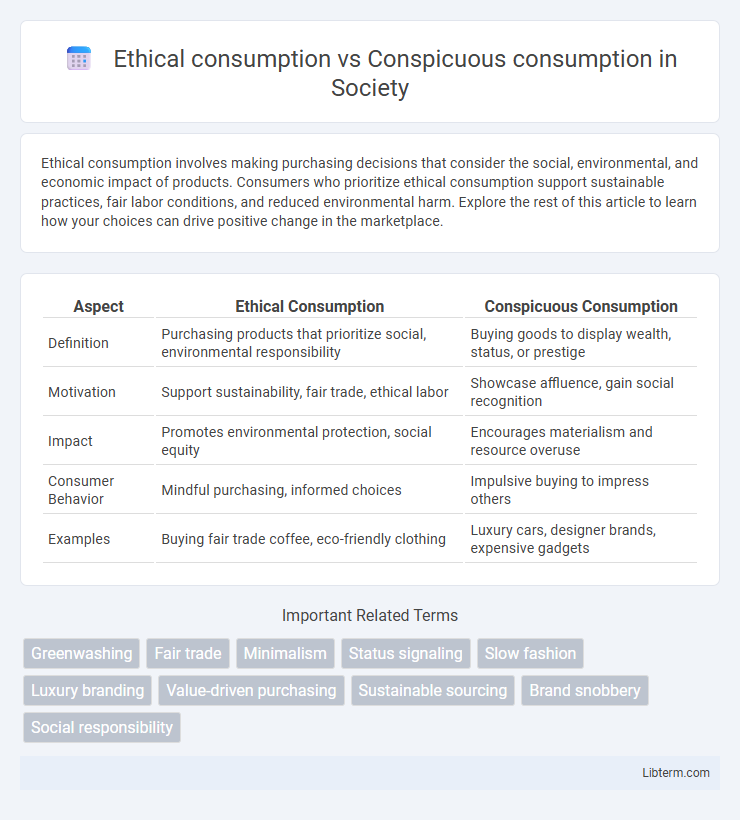Ethical consumption involves making purchasing decisions that consider the social, environmental, and economic impact of products. Consumers who prioritize ethical consumption support sustainable practices, fair labor conditions, and reduced environmental harm. Explore the rest of this article to learn how your choices can drive positive change in the marketplace.
Table of Comparison
| Aspect | Ethical Consumption | Conspicuous Consumption |
|---|---|---|
| Definition | Purchasing products that prioritize social, environmental responsibility | Buying goods to display wealth, status, or prestige |
| Motivation | Support sustainability, fair trade, ethical labor | Showcase affluence, gain social recognition |
| Impact | Promotes environmental protection, social equity | Encourages materialism and resource overuse |
| Consumer Behavior | Mindful purchasing, informed choices | Impulsive buying to impress others |
| Examples | Buying fair trade coffee, eco-friendly clothing | Luxury cars, designer brands, expensive gadgets |
Understanding Ethical Consumption
Ethical consumption involves making purchasing decisions that prioritize environmental sustainability, social justice, and animal welfare, emphasizing products with transparent supply chains and fair trade certifications. Consumers practicing ethical consumption often research product origins, support local artisans, and avoid items contributing to exploitation or environmental harm. This behavior contrasts with conspicuous consumption, which centers on acquiring luxury goods to signal status rather than ethical values or sustainability considerations.
Defining Conspicuous Consumption
Conspicuous consumption refers to the practice of purchasing goods or services to publicly display wealth, social status, or prestige rather than to meet basic needs. This type of consumption is often characterized by luxury brands, extravagant spending, and the pursuit of social recognition through material possessions. Contrasted with ethical consumption, which emphasizes sustainability and social responsibility, conspicuous consumption prioritizes image and social differentiation.
Historical Perspectives on Consumer Behavior
Historical perspectives on consumer behavior reveal that ethical consumption emerged as a response to the excesses of conspicuous consumption, which gained prominence during the Gilded Age in the late 19th century. Conspicuous consumption, characterized by the public display of wealth through material goods, was extensively analyzed by sociologist Thorstein Veblen in his 1899 work, *The Theory of the Leisure Class*. Over time, increasing awareness of social and environmental consequences led to the rise of ethical consumption movements that prioritize sustainability, fairness, and social responsibility over ostentatious materialism.
Drivers Behind Ethical Purchasing Decisions
Consumers driven by ethical consumption prioritize environmental sustainability, fair trade practices, and social responsibility when making purchasing decisions. Key motivators include increasing awareness of climate change, desire to support labor rights, and preference for products with transparent supply chains. Ethical consumers often seek certifications like Fair Trade, organic labels, and cruelty-free endorsements as tangible evidence of responsible production.
Social Influences and Status Symbolism
Ethical consumption emphasizes sustainable choices influenced by social norms valuing environmental responsibility and social justice, often signaling a commitment to collective well-being rather than personal status. Conspicuous consumption prioritizes visible luxury goods and brands as status symbols, driven by social influence to convey wealth and prestige in competitive social environments. The contrast highlights how social influences shape consumer behavior either towards ethical identity alignment or status-driven materialism.
Environmental Impact: Ethics vs Excess
Ethical consumption prioritizes reducing carbon footprints and minimizing waste by choosing sustainable and eco-friendly products, significantly lowering environmental degradation. Conspicuous consumption drives excess production and resource depletion, leading to increased pollution, deforestation, and greenhouse gas emissions. The environmental impact starkly contrasts as ethical consumption supports conservation efforts, while conspicuous consumption accelerates ecological harm through unsustainable practices.
Marketing’s Role in Shaping Consumption Patterns
Marketing plays a critical role in shaping consumption patterns by promoting ethical consumption through transparency, sustainability messaging, and eco-friendly branding that appeals to socially conscious consumers. Conversely, marketing often fuels conspicuous consumption by associating products with status, luxury, and exclusivity, leveraging emotional appeals and influencer endorsements to drive demand for prestige goods. These contrasting strategies reflect how marketers influence consumer behavior by aligning products either with ethical values or social prestige to shape purchasing decisions.
Challenges and Barriers to Ethical Consumption
Ethical consumption faces significant challenges such as higher costs, limited availability of sustainable products, and lack of consumer awareness, which hinder widespread adoption. Barriers include entrenched social norms favoring conspicuous consumption, where status is demonstrated through luxury goods rather than ethical values. Overcoming these obstacles requires systemic changes in market practices, education on sustainability, and improved access to affordable ethical options.
Case Studies: Brands and Consumer Choices
Brands like Patagonia exemplify ethical consumption by prioritizing environmental sustainability and transparent supply chains, influencing consumer choices towards responsible purchasing. In contrast, luxury brands such as Gucci often drive conspicuous consumption with status-driven marketing and limited-edition products that appeal to social signaling. Case studies reveal consumers increasingly weigh ethical considerations alongside brand prestige, shifting market dynamics toward sustainable luxury offerings.
The Future of Responsible Consumption
The future of responsible consumption hinges on the shift from conspicuous consumption, which emphasizes status through material goods, to ethical consumption that prioritizes sustainability, social equity, and environmental impact. Increasing consumer awareness and regulatory frameworks drive demand for transparent supply chains, eco-friendly products, and fair labor practices. Digital technology and blockchain innovations support accountability and traceability, enabling consumers to make informed, conscientious purchasing decisions that foster long-term planetary and societal well-being.
Ethical consumption Infographic

 libterm.com
libterm.com